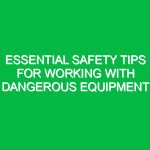Introduction
Hello team! Today, we’re going to have an important Toolbox Talk about a crucial aspect of Workplace Safety – the **Types of Fire Extinguishers**. As we prepare to start our workday, understanding fire Safety and the right equipment to use in case of a fire is essential. Fire incidents can happen at any time, and being prepared can mean the difference between a small incident and a major disaster.
In this talk, we will cover the different types of fire extinguishers, their specific uses, and Best Practices for ensuring Safety in our workplace. Let’s dive in!
Understanding Fire Extinguishers
Before we discuss the different types of fire extinguishers, let’s take a moment to understand what a fire extinguisher is. A fire extinguisher is a portable device that is used to put out small Fires or control them until the fire department arrives. They are essential in every workplace, and knowing how to use them effectively can save lives and property.
Why Are Fire Extinguishers Important?
Fire extinguishers are vital for several reasons:
- Prevention of Fire Spread: They can quickly suppress a fire, preventing it from spreading and causing more damage.
- Safety of Employees: Knowing how to use a fire extinguisher can protect you and your coworkers from harm.
- Compliance with Regulations: Fire safety regulations require workplaces to have appropriate fire extinguishing equipment.
Types of Fire Extinguishers
Now, let’s discuss the different **Types of Fire Extinguishers** available. Understanding these types will help you choose the right extinguisher for the specific fire hazard you might encounter in the workplace.
1. Water Extinguishers (Class A)
Water extinguishers are one of the most common types and are primarily used for Class A fires, which involve ordinary combustibles such as wood, paper, and textiles.
- How They Work: They work by cooling the burning material below its ignition temperature.
- Usage: Use water extinguishers only on Class A fires. NEVER use them on electrical fires or flammable liquids.
2. Foam Extinguishers (Class A and B)
Foam extinguishers can tackle both Class A and Class B fires, making them versatile for various situations.
- How They Work: They form a layer of foam that blankets the fire, cutting off its oxygen supply.
- Usage: Ideal for fires involving flammable liquids such as paints or solvents.
3. Dry Powder Extinguishers (Class A, B, and C)
Dry powder extinguishers are suitable for Class A, B, and C fires, making them one of the most versatile options.
- How They Work: They discharge a fine powder that smothers the fire.
- Usage: Effective on fires involving flammable gases, liquids, and solids.
4. Carbon Dioxide (CO2) Extinguishers (Class B and C)
CO2 extinguishers are most effective for Class B and C fires, particularly in environments where electrical equipment is present.
- How They Work: They displace oxygen and cool the fuel.
- Usage: Ideal for electrical fires and flammable liquids. Be aware that CO2 extinguishers can cause frostbite if used improperly.
5. Wet Chemical Extinguishers (Class F)
Wet chemical extinguishers are specifically designed for Class F fires, which involve cooking oils and fats.
- How They Work: They cool the flames and create a barrier between the oxygen and the fuel.
- Usage: Use them in kitchens or areas where cooking is done.
6. Class D Extinguishers
Class D extinguishers are used for fires involving combustible metals, such as magnesium or titanium.
- How They Work: They use a dry powder that does not react with metals.
- Usage: These extinguishers are specific to certain industries that handle combustible metals.
Choosing the Right Fire Extinguisher
Understanding the **Types of Fire Extinguishers** is just the first step. It’s equally important to know how to choose the right one based on the fire risk in your area.
- Assess the Risks: Identify the types of materials and processes present in your work area. This will help you determine which extinguishers are necessary.
- Placement: Ensure extinguishers are easily accessible and visible. They should be placed near potential fire Hazards but away from those Hazards.
- Regular Maintenance: Fire extinguishers should be inspected regularly to ensure they are in working order. Check the pressure gauge and ensure there are no visible signs of damage.
Best Practices for Using Fire Extinguishers
In case of a fire, knowing how to use a fire extinguisher properly is crucial. Here are some Best Practices to follow:
1. Remember the PASS Technique
The PASS technique is a simple acronym to help you remember how to operate a fire extinguisher:
- P: Pull the pin to break the tamper seal.
- A: Aim low at the base of the fire.
- S: Squeeze the handle to release the extinguishing agent.
- S: Sweep from side to side until the fire is out.
2. Always Stand at a Safe Distance
Maintain a safe distance while using a fire extinguisher. Most extinguishers are effective from a distance of about 6-8 feet, depending on the type.
3. Know When to Evacuate
If a fire is too large or spreading rapidly, evacuate immediately. Your safety is the top priority. Do not attempt to fight a fire if you feel unsafe or untrained to do so.
4. Inform Others
If you use a fire extinguisher, alert your coworkers and the emergency services. Always call for help, even if you think you have controlled the fire.
Potential Hazards and Safety Considerations
While fire extinguishers are essential, they can also pose hazards if not used correctly. Here are some potential risks:
- Improper Use: Using the wrong type of extinguisher on a fire can make it worse. Always ensure you have the right extinguisher for the specific fire class.
- Distraction: Focusing too much on extinguishing a fire can distract you from evacuating effectively. Know your escape routes.
- Frostbite: CO2 extinguishers can cause frostbite if sprayed directly on skin. Always use with caution.
Regulations and Standards
In many regions, there are specific regulations governing the types and placement of fire extinguishers in workplaces. Familiarize yourself with local fire safety codes and your company policies regarding fire safety equipment. Compliance with these regulations not only keeps you safe but also protects the company from legal liabilities.
Conclusion
In summary, understanding the **Types of Fire Extinguishers** and how to use them effectively is crucial for maintaining a safe working Environment. Remember to assess your surroundings, choose the appropriate extinguishers, and follow best practices when using them. Your safety and the safety of your colleagues depend on it.
Thank you for your attention to this important topic. Let’s keep our workplace safe by being prepared and knowledgeable about fire extinguishers. If you have any questions or want to discuss fire safety further, feel free to share your thoughts.


